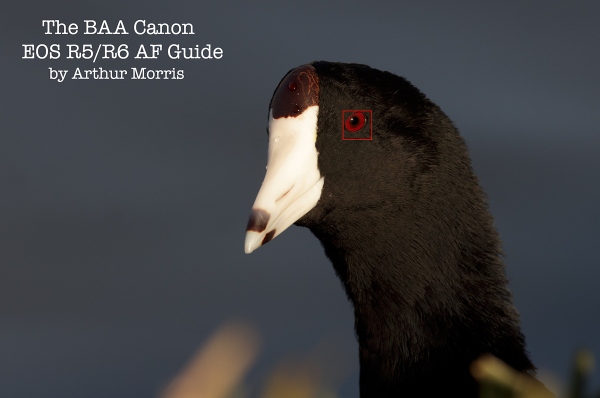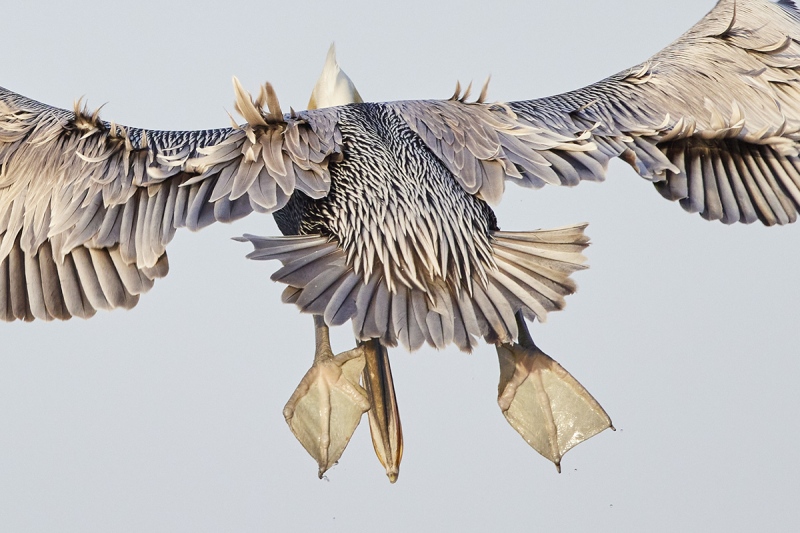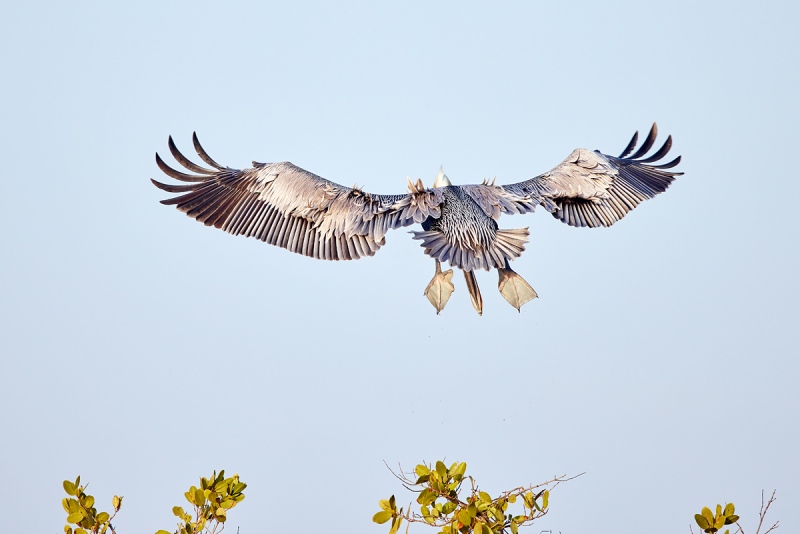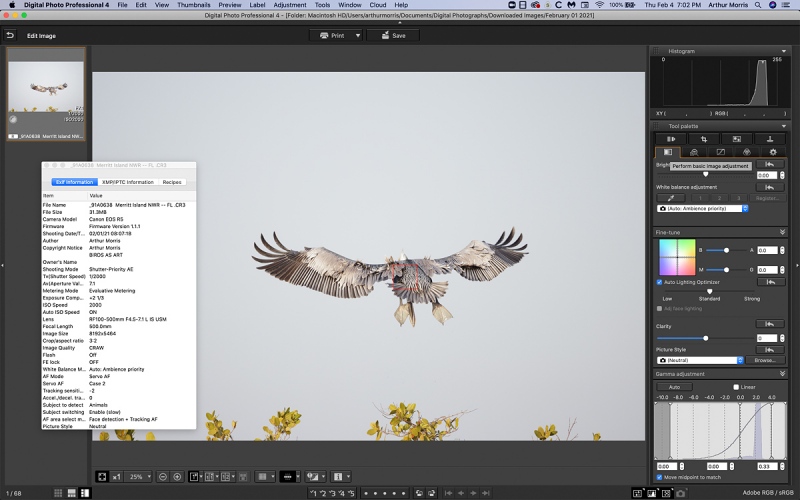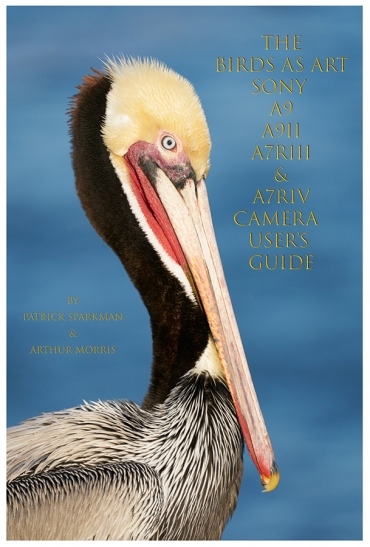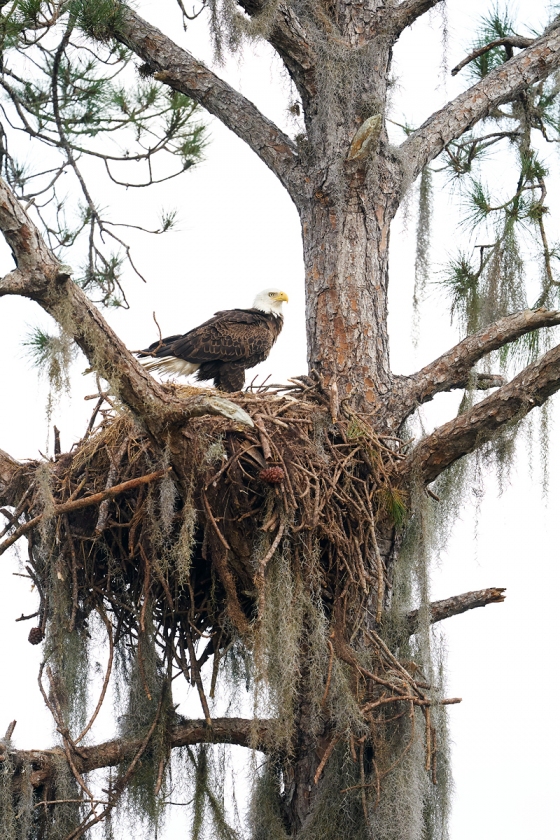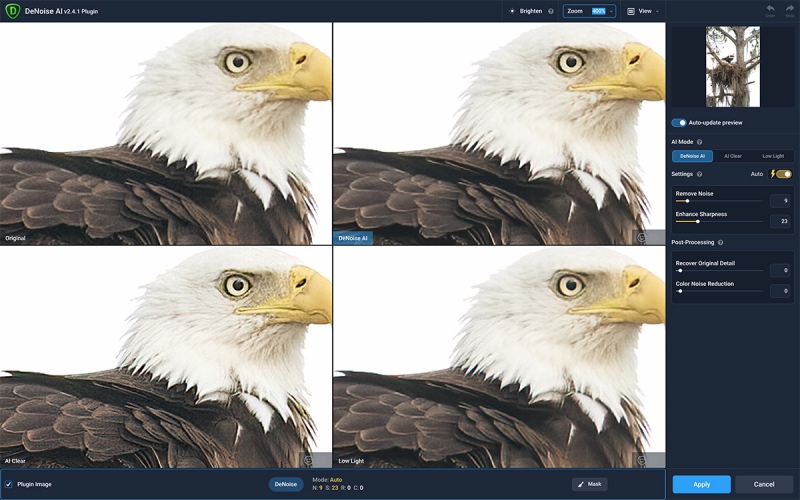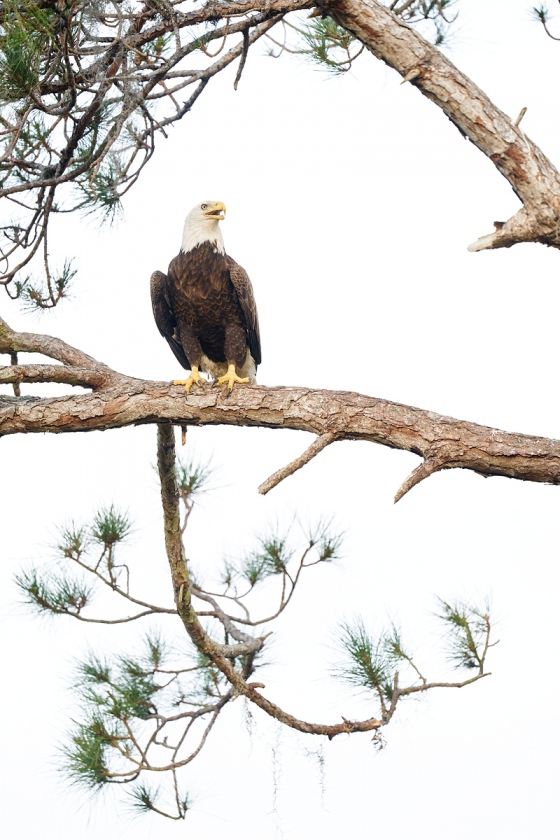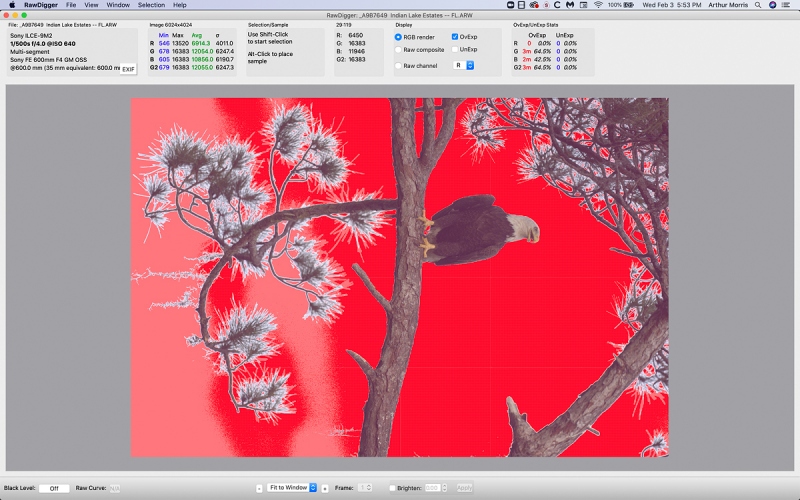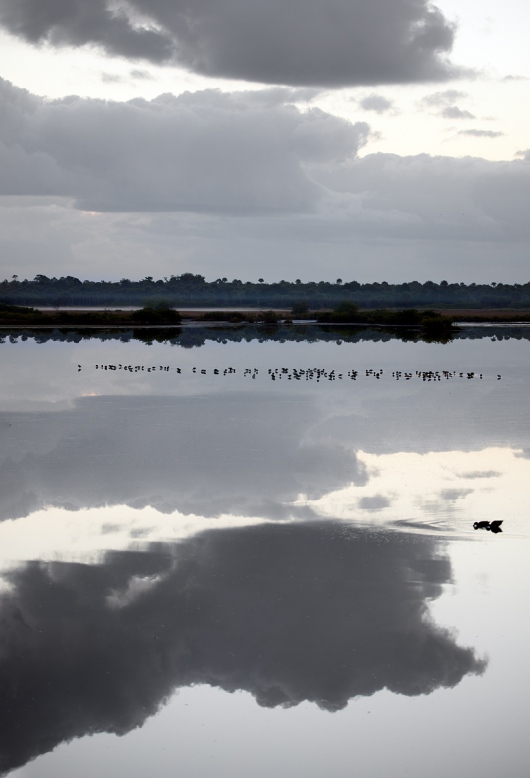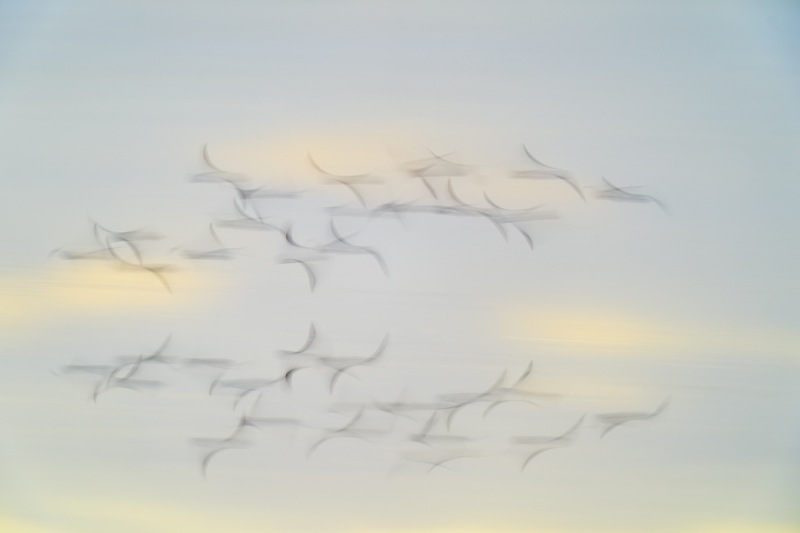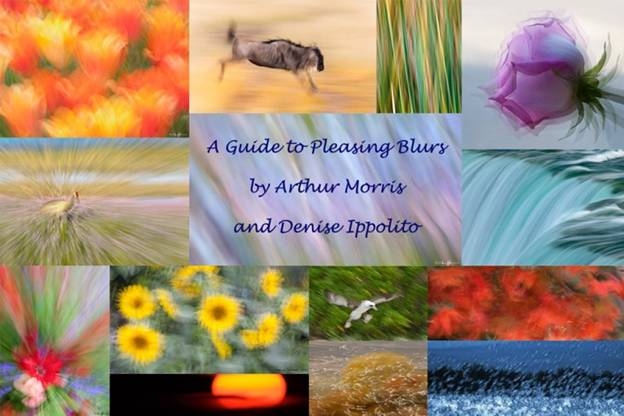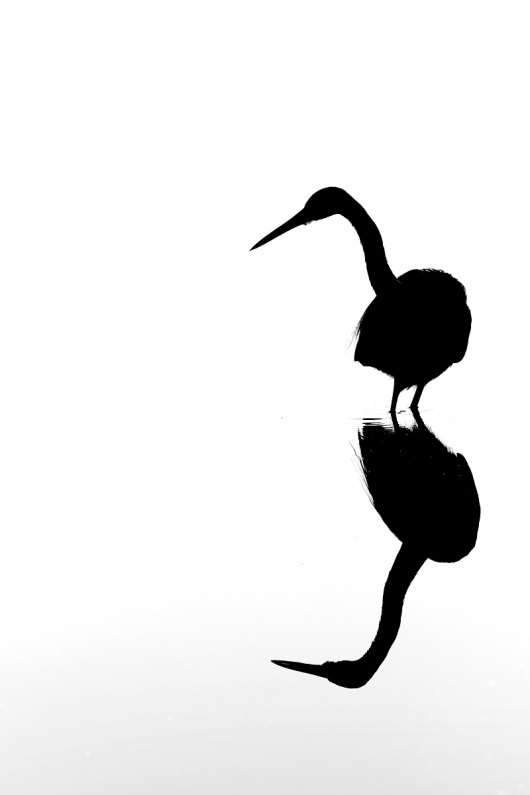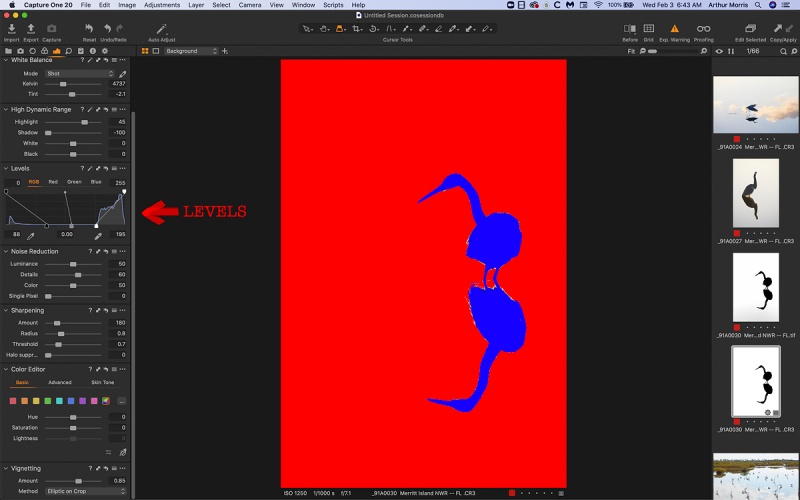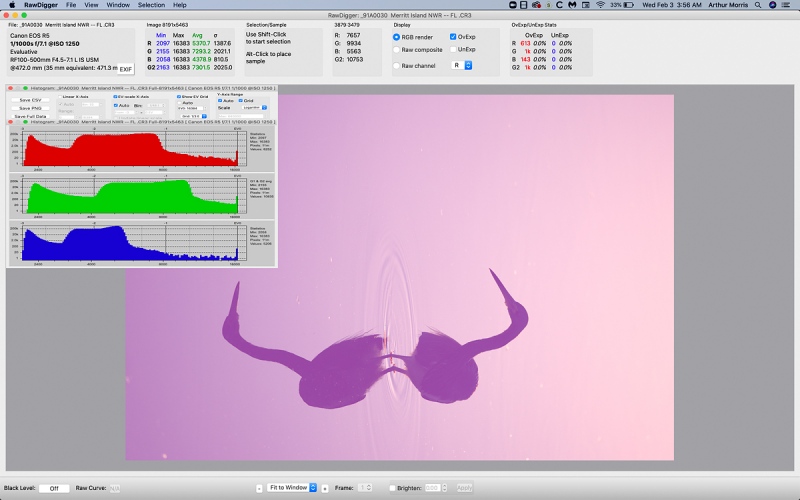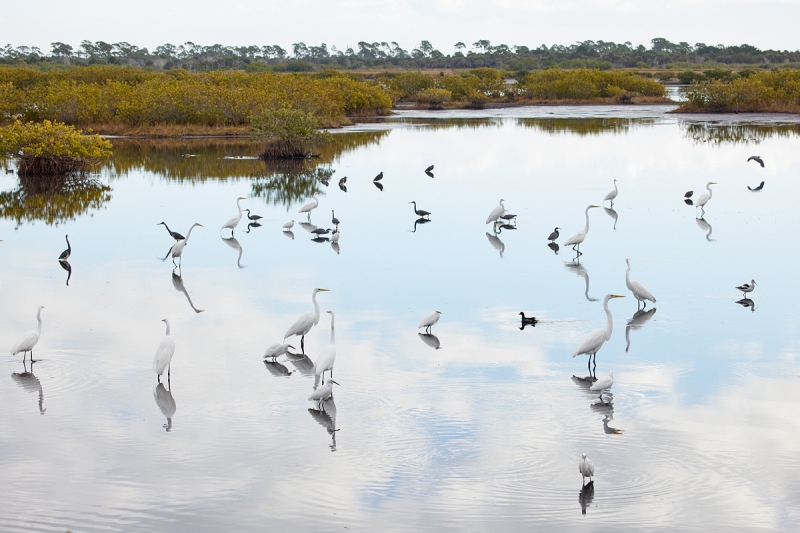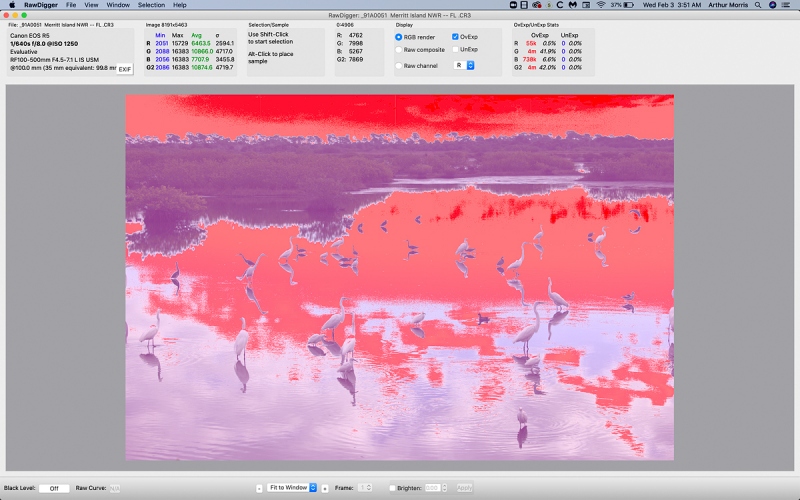Image Worthiness Question
Would you have kept today’s featured image or deleted it? Why?
What’s Up?
I did get down to the lake on Thursday morning and pushed the shutter button a few times. There was nothing memorable, but I did learn a bunch and came up with a few more things I need to figure out. Pretty much par for the course … Sunset looked fairly promising last night. I went down but with the wind with just a hint of west in it had most of the birds landing away from me. The eagle flew by early on and flushed about 100 wading birds from the roost but they never quite made it into the color and landed well to my left. All in all it was great getting out after two days of photo-inactivity.
As predicted, I skipped my swim because of the extreme cold. It is ten degrees warmer here this morning, and the forecast for today — Friday 5 February 2021, is for clear skies with south winds turning to the SW at about 9am. I may set out the road-kill cafe for the vultures. I am hoping that the heater/chiller does its work and gets the pool near 80 degrees so that I can do my swim this afternoon.
I did get a ton of work done yesterday on both the Canon R5/R6 AF e-Guide and on the Canon EOS R5 Camera User’s e-Guide as well. And I plan to do the same today.
This blog past makes forty-seven days in a row with a new blog post. This one took about two hours to prepare. Please remember …
Please Remember
With income from IPTs now at zero, please, if you enjoy and learn from the blog, remember to use one of my two affiliate programs when purchasing new gear. Doing so just might make it possible for me to avoid having to try to get a job as a Walmart greeter and will not cost you a single penny more. And if you use Bedfords and remember to enter the BIRDSASART code at checkout, you will save 3% on every order and enjoy free second-day air shipping. In these crazy times — I am out at least forty to sixty thousand dollars so far due to COVID 19 (with lots more to come) — remembering to use my B&H link or to shop at Bedfords will help me out a ton and be greatly appreciated. Overseas folks who cannot order from the US because of import fees, duties, and taxes can always help out by clicking here if they see fit.
Levered-Clamp FlexShooter Pro News
We now have two dozen (make that 23) Levered-Clamp FlexShooter Pro heads in stock. The ballhead that acts like (but is much lighter than) a gimbal-head, and that serves all purposes, has — as I predicted when I first used a FlexShooter Pro head — taken the world of nature photography by storm. And it’s all on the level too!
The BAA Used Gear Page
The Used Gear page continues to be very active. The BAA Used Gear Page is the place to sell your used photographic equipment. We will help you to get your gear sold quickly for 20 to 60% or more than what the big guys are offering … Doubt me? Check out the Recent Sales list for the past eleven months at the bottom of the page.
Price Drops
Canon EOS-1DX Mark III professional digital camera body
Price Reduced $200 on 4 FEB 2021
Used Gear Page regular Don Busby is offering a Canon EOS-1DX Mark III dSLR in like-new condition with less than 10,000 shutter actuations for a very low $5299.00 (was $5499.00). The sale includes the original box and everything that came in it including the 64gb CF Express Card, the CFexpress reader, and an extra battery. Also included is insured ground shipping via major courier to lower-48 US addresses only. Your item will not ship until your check clears unless other arrangements are made.
Please contact Don via e-mail
The Canon 1Dx bodies have been solid performers under challenging conditions for many years. The autofocus performance of the 1Dx and 1Dx MkII had been lacking as compared to Nikon or lately Sony (A9) especially when it comes down to dynamic focusing using the whole sensor array or specific zones. on the 1DX Mark II, the Automatic AF area selection never did a great job of acquiring and tracking the subject; thus, that mode was pretty much useless for photographing birds in flight. Single-point AF or AF Expand (4 or 9 points) with the tracking sensitivity set at -2 often produced good results for me with flying birds, but the fact that you were limited as far as image design always bothered me. Nikon’s dynamic focusing and Sony’s tracking capabilities provided extra compositional flexibility. As a result, many bird photographers decided to leave Canon and switch to Nikon or a Sony a9 series body. I decided to stay the course with Canon for two reasons: my collection of great Canon lenses, and the fact that the development of sensor and AF technology is like an arms race: one day Nikon is ahead, the next day Canon is ahead. I was lucky enough to get the new Canon 1Dx MkIII camera body from Steve Elkins just in time for my trip to Alaska to photograph the bald eagles. It was the perfect place to test the improved AF capabilities of the new Canon flagship body, the EOS-1D X Mark III DSLR with CFexpress Card and Reader.
The 1Dx MkIII is a hybrid camera with an Optical Viewfinder (OVF) and Live-View shooting making it a mirrorless camera at the same time that it is a rugged dSLR. There are a ton of other great new features, but I focused primarily on testing the new enhanced AF system. I was especially interested to see if the new dynamic 191-point Automatic AF selection and the AF zones would perform better than the previous versions of the 1Dx. The conclusion is that even under difficult circumstances — the first two days with heavy winds and heavy snow) — the camera had no issue focusing on the subject and keep tracking it with the Automatic AF selection mode. I used the center point to acquire focus and as soon as it locked the focus on the bird, it did a great job keeping multiple AF points on the subject and tracking it through the frame and through the snowflakes. The same applied for the Zones — smaller AF areas with multiple AF points active. Even with busy backgrounds, the AF stayed locked on the subject. The AF modes have been reduced to 4 compared to 5 in the previous 1Dx models. I primarily used Mode 2 (Continue to Track Subjects, Ignoring Possible Obstacles) and Mode 4 (For Subjects That Accelerate or Decelerate Quickly) but was not able to see a significant difference between the modes. Even with trying the “Deep Learning” Automatic setting (Tracking Automatically Adapts to Subject Movement) I did not notice a significant difference. They all performed really well. The conclusion is that Canon has produced a camera that is now on-par or even better than its competitors with respect to AF performance. Although I did not test the mirrorless capabilities yet, other tests show that this function is also equal to or better than the Sony A9 performance, the only difference is that you can not use the OVF in mirrorless-mode with the 1DX III and have to use the display on the back of the camera (the rear monitor) instead. Due to the fact you have to keep the camera away from your eye, this is somewhat awkward for photographing birds in flight. I am very happy with the AF performance as compared to the previous Canon models and am looking forward to testing it further on Florida birds this coming spring. Clemens van der Werf
The 1DX III sells new right now for $6,499.00. Grab Don’s almost new body, save a $1000.00, and get an extra battery to boot! I remember how thrilled Clemens was with his then brand-new 1DX III in Homer. You can see some of his eagle images made with the 1DX iii in the Field-testing the New Canon EOS-1DX Mark III at Homer: World-Class Nature Photographer Clemens Van der Werf Shares the Skinny on Canon’s New Flagship Camera Body post here. artie
Sony Alpha a9 Mirrorless Digital Camera Body
Price Reduced $200 on 4 FEB 2021
Craig Mossey is offering a SONY A9 body in excellent condition with 4304 shutter actuations for $1998.00 (was $2,198.00). The sale includes the original box, one, battery, the battery charger, the USB wall plug and charging cord, the original documentation, the front body cap, the strap, and insured FEDEX ground shipping to lower US addresses only. Your item will not ship until your payment clears (Zelle, PayPal or check) unless other arrangements are made.
Please contact Craig via e-mail or by phone at 1-561.447.2911 Eastern time zone.
I was sold on SONY five minutes after trying my SONY a9 on the incoming Brandt’s Cormorants at La Jolla, CA. The AF system is identical to the AF system on the more expensive a9 ii that costs $4,498.00. The a9 ii body is about 1/8 inch thicker than the a9 ii. If you do not have large hands, or if you like the feel of a smaller body, you will love the a9. And if you like the feel of $1,200.00 in your pocket — the a9 sells for $3,398.00 — get in touch with Craig ASAP. artie
Sony Alpha a7r IV Mirrorless Digital Camera Body
Price Reduced $200 on 5 FEB 2021
Craig Mossey is offering a SONY a7r iv in near-mint condition with 3049 shutter actuations for the BAA record-low price of $2198.00 (was $2398.00). The sale includes the original box, one battery, the battery charger, the USB wall plug and charging cord, the original documentation, the front cap, the camera strap, and insured FEDEX ground shipping to lower US addresses only.
Please contact Craig via e-mail or by phone at 1-561.447.2911 Eastern time zone.
For the past two years you have seen the incredible detail in my a7r IV images made with a variety of SONY lenses and both teleconverters. I’ve typically used my 7r IV for about 50% of my bird photography and my a9 II in pure flight situations. As the 7r IV sells new right now for $3498.00, you can save a cool $1100.00 by grabbing Craig’s practically new a7r iv. Though this 61-MP body is especially attractive to landscape and macro photographers, it is great for birds as well as you can pretty much crop to your heart’s content. artie
Canon R5/R6 AF e-Guide Info
So far, 96 folks have sent PayPals for their copy of the Canon R5/R6 AF e-Guide. And 33 who used my affiliate links to purchase their R5 have e-mailed for and received their free copy of the guide. If you e-mailed your Bedford receipt or sent a PayPal and did not receive your guide, please LMK immediately via e-mail.
Feedback has been overwhelmingly positive so far. Three folks wrote stating that they had a better way of setting up AF on their R5s. When I wrote back explaining why they were in error, two of them back-tracked. One stubborn guy is still doing it his way — less efficiently. Be sure to scroll down to read about my plans for a Canon R5/R6 User’s e-Guide. Understand that the info in the BAA Canon R5/R6 Autofocus e-Guide is so important that I opted to publish the AF guide immediately as the R5/R6 User’s Guide will take at least another month to finish.
|
|
BAA Canon R5/R6 Autofocus e-Guide |
BAA Canon R5/R6 Autofocus e-Guide
Twenty-one pages. 3,452 words. 28-DPP4 screen captures showing the R5’s vaunted AF system in action. Note: the AF system of the R5 is identical to the AF system of the R6.
You will learn:
1- The two most useful AF Methods for general bird photography and for birds in flight.
2- How to set up your R5/R6 AF Menus.
3- What boxes to check (and un-check) under Limit AF Methods.
4- How to change the AF Method quickly, easily, and efficiently. Note: the default way of doing this is clunky, cumbersome, and inefficient at best. One person replied that this tip alone was worth the price of admission.
5- The only setting that should be used for Initial Servo AF pt for Face Detection + Tracking.
I you are currently using multiple back buttons either for general bird photography or for birds in flight, what you learn in this guide will change your life. For the better.
Here are the first three paragraphs of this e-Guide:
From the moment I learned about the new Canon mirrorless bodies, I read about using two or three back-buttons to focus using different AF methods. The word on the street said that the way to go for birds in flight was to use one button to acquire focus with Zone AF or with Large Zone: Horizontal AF and then switch to another button to activate Face Detection + Tracking AF and then use the shutter button to make an image. My immediate thought was, “This is insanity! There has got to be a better way.” In short, there is a far superior way to set up AF on your R5 or R6.
Remember that I got away from any form of back-button or rear focusing many years ago after finally realizing that it is always easier to do one thing (press the shutter button), than it is to do two things (press a back button and then press the shutter button).
The default method of switching AF Methods with the R5/R6 bodies is cumbersome at best. It involves first pressing the grid button (my name) on the upper right back of the camera and then pressing the hard-to-access M-Fn button to toggle through the AF Methods. This method is so bad that it will not be mentioned again in this guide.
The guide is free to all who have ordered an R5 or an R6 using my B&H affiliate link or from Steve Elkins/Bedfords using the BIRDSASART coupon code at checkout. Please send your receipt to me via e-mail. It will take me a few days to a week to verify the B&H purchases. Bedfords folks should expect their free e-Guides fairly quickly.
To purchase your copy of the e-Guide, please click here or send a PayPal for $25.00 to birdsasart@verizon.net and be sure to include the words R5/R6 AF Guide in your PayPal e-mail.
Everyone who gets the guide will receive a free update no later than the first week in February.
Canon EOS R5 Camera User’s e-Guide
As regular readers know, I am working on a complete Canon R5 Camera User’s e-Guide. This will require a lot of research, a lot of time, and a lot of effort. I am hoping to have it complete by late February. As always, folks who use the BAA affiliate links to purchase their Canon gear will receive a substantial discount.
Understand that the info in the BAA Canon R5/R6 Autofocus e-Guide is so important that I opted to publish the AF guide right off the bat to help folks get started with their new camera bodies. I may soon offer a pre-publication version of the User’s e-Guide … With a small discount, of course.
New and Better Bedfords Discount Policy!
You can now save 3% on all of your Bedfords photo gear purchases by entering the BIRDSASART coupon code at checkout. Your discount will be applied to your pre-tax total. In addition, by using the code you will get 2nd day air shipping via Fed Ex.
Grab a Nikon AF-S Teleconverter TC-14E III and save $14.99. Purchase a Canon EOS R5 and your discount will be $116.97. Purchase a Sony FE 600mm f/4 GM OSS lens and save a remarkable $389.94! Your Bedford’s purchase no longer needs to be greater than $1,000.00 for you to receive a discount. The more you spend, the more you save.
Money Saving Reminder
Many have learned that if you need a hot photo item that is out of stock at B&H and would enjoy free overnight shipping, your best bet is to click here, place an order with Bedfords, and enter the coupon code BIRDSASART at checkout. If an item is out of stock, contact Steve Elkins via e-mail or on his cell phone at (479) 381-2592 (Central time). Be sure to mention the BIRDSASART coupon code and use it for your online order to save 3% and enjoy free 2nd-day air shipping. Steve has been great at getting folks the hot items that are out of stock at B&H and everywhere else. The wait lists at the big stores can be a year or longer for the hard to get items. Steve will surely get you your gear long before that. For the past year, he has been helping BAA Blog folks get their hands on items like the SONY a9 ii, the SONY 200-600 G OSS lens, the Canon EOS R5, the Canon RF 100-500mm lens, and the Nikon 500mm PF. Steve is personable, helpful, and eager to please.


Gear Questions and Advice
Too many folks attending BAA IPTs (remember those?) and dozens of photographers whom I see in the field and on BPN, are–out of ignorance–using the wrong gear especially when it comes to tripods and more especially, tripod heads… Please know that I am always glad to answer your gear questions via e-mail. Those questions might deal with systems, camera bodies, accessories, and/or lens choices and decisions.
|
|
Image #1: tight crop of the Brown Pelican landing in wind-against-sun conditions image |
The Unfortunate Bill-foot Merge
As I went after the image that I wanted, I tried to get one with the bill centered between the feet. But this was as good as I could do. So I decided to try the new Photoshop Bill-Shifter Tool (Keyboard shortcut = BS). As you can see by scrolling down to Image #1A, it worked perfectly. All with just one click. Don’t forget to use the BS keyboard shortcut!
|
|
|
This image was created on 2 February 2021 at Black Point Drive, Merritt Island NWR. Working away from my vehicle, I used the handheld Canon RF 100-500mm f/4.5-7.1L IS USM lens (at 500mm) and the highly touted 45MP Canon EOS R5 Mirrorless Digital camera body. Evaluative metering +2 1/3 stops. Auto ISO set ISO 2000: 1/2000 sec. at f/7.1 (wide open) in Shutter Priority-AE (Tv) mode. RawDigger showed to be a slight over-exposure. (In retrospect, an EC of +2 would have been perfect.) AWB at 8:07am on a mostly sunny morning. Face (Back?) Detection + Tracking/AI Servo AF was active at the moment of exposure and performed well; see the DPP 4 screen capture below. Image #1A: Brown Pelican landing in wind-against-sun conditions |
The Optimized Image
After converting the raw file in Capture One, I rought the image into Photoshop and executed a relatively small crop with the Delete Cropped Pixels box checked (to make less work for Topaz DeNoise AI). Next was a layer of DeNoise on Auto. Then I centered the bill with one click via BS and played around a bit with the color and contrast.
Wind-Against-Sun Flight
Regular readers know that wind-against-sun conditions make bird photography difficult. And that goes double for flight photography. At Merritt Island on my last morning, the wind was brisk from the NW while the sun was in the southeast, making for classic wind-against-sun conditions. As a result, most birds were flying and facing and landing — as here — away from me. When I saw this pelican struggling to land atop the somewhat flimsy mangroves, I saw the opportunity to go for the back flight-shot with the wings fully spread and the bird’s feet hanging down.
Remember that the sun was behind me and the wind was in my face when I created this image. When all you have are lemons, making lemonade (or soup from a stone) is always a good option.
|
|
Image #1B: Brown Pelican landing in wind-against-sun conditions |
Tracking Plus “Back” Detection AF with the R5
I continue to experiment with Face Detection + Tracking/AI Servo AF (and also with Zone AF), for flight photography with the R5. Yesterday, while working on the update of the Canon R5/R6 AF e-Guide, here. — in part — is what I wrote in the section on what happens when the system cannot see a face or an eye to detect:
If there is no detectable face or eye in the frame when you half-press the shutter button, the system will focus on what it thinks is the subject. It generally does that quite well (as long as there is some contrast).
Note the large red AF box on the left side of the pelican’s back. I would not want it anywhere else and the image was sharp where it needed to be.
BS Questions
If you have a question on any of the BS in today’s blog post, please leave it as a comment below.
Typos
In all blog posts and Bulletins, feel free to e-mail or to leave a comment regarding any typos or errors.

